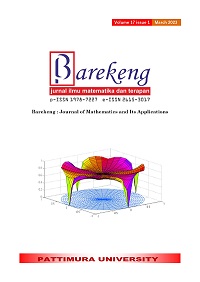PREDICTION OF THE POOR RATE K-MEANS AND GENERALIZED REGRESSION NEURAL NETWORK ALGORITHMS (CASE STUDY: NORTH SUMATRA PROVINCE)
Abstract
Poverty reduction is a crucial issue and the primary The North Sumatra Provincial government's main concern is lowering the poverty rate, which is a crucial issue. The Province of North Sumatra in Indonesia, one of many nations affected by the Covid-19 pandemic, is particularly troubled economically. In this study, poverty levels were mapped using the K-Means algorithm, and GRNN was then utilized for modeling and prediction. The data source used is time series data from 2010 to 2020 from the Central Statistics Agency (BPS), which includes variables X covering population, health, education, unemployment, and asset ownership and variable Y representing poverty level. The goal of this study is to choose the best model for estimating poverty levels in North Sumatra Province. The districts and cities of Deli Serdang and Medan have the greatest rates of poverty, according to the K-means algorithm's mapping of poverty levels. Additionally, the results of the predicting produced MSE values of 0.004659 and RMSE values of 0.00002108. The value of the smoothness parameter is 0.01.
Downloads
References
S. Hanoatubun, “Dampak COVID – 19 Terhadap Perekonomian Indonesia,” J. Educ. Phychology an Couns., vol. 2, no. 1, pp. 146–143, 2020.
F. Rizal and H. Mukaromah, “Filantropi Islam Solusi Atas Masalah Kemiskinan Akibat Pandemi Covid-19,” AL-MANHAJ J. Huk. dan Pranata Sos. Islam, vol. 3, no. 1, pp. 35–66, 2021.
M. Mulyadi, “Peran Pemerintah dalam Mengatasi Pengangguran dan Kemiskinan dalam Masyarakat,” J. Kaji., vol. 21, no. 3, pp. 221–236, 2016.
R. S. Dewi and O. N. I. N. Irama, “Pengaruh Alokasi Dana Desa Terhadap Kemiskinan,” J. Akutansi Dan Bisnis, vol. 4, no. 2, p. 11, Nov. 2018.
R. Rosmini, A. Fadlil, and S. Sunardi, “Implementasi Metode K-Means Dalam Pemetaan Kelompok Mahasiswa Melalui Data Aktivitas Kuliah,” IT J. Res. Dev., vol. 3, no. 1, pp. 22–31, 2018.
Y. R. Sari, A. Sudewa, D. A. Lestari, and T. I. Jaya, “Penerapan Algoritma K-Means Untuk Clustering Data Kemiskinan Provinsi Banten Menggunakan Rapidminer,” CESS (Journal Comput. Eng. Syst. Sci., vol. 5, no. 2, pp. 192–198, 2020.
W. M. P. Dhuhita, “Clustering Menggunakan Metode K-Means Untuk,” J. Inform., vol. 15, no. 2, pp. 160--174, 2016.
N. D. Saksono, Y. A. Sari, and R. K. Dewi, “Rekomendasi Lokasi Wisata Kuliner di Jakarta Menggunakan Metode K-means Clustering dan Simple Additive Weighting,” J. Ilmu Komput. dan Sist. Inf., vol. 7, no. 1, pp. 14–21, 2019.
M. Nishom, “Perbandingan Akurasi Euclidean Distance, Minkowski Distance, dan Manhattan Distance pada Algoritma K-Means Clustering berbasis Chi-Square,” J. Inform. J. Pengemb. IT, vol. 4, no. 1, pp. 20–24, Jan. 2019.
E. Fatchurin, A. Fanani, and M. Hafiyusholeh, “Peramalan Penggunaan Bahan Bakar Pada Pembangkit Listrik Tenaga Gas Uap Menggunakan Metode Backpropagation Neural Network,” J. Ris. dan Apl. Mat., vol. 4, no. 2, pp. 1–8, 2020.
M. Alkaff and Y. Sari, “Penerapan Generalized Regression Neural Networks untuk Memprediksi Produksi Padi Terhadap Perubahan Iklim,” J. Teknol. Rekayasa, vol. 2, no. 2, p. 117, 2017.
S. Herawati, “Peramalan Kunjungan Wisatawan Mancanegara Menggunakan Generalized Regression Neural Networks,” J. Infotel, vol. 8, no. 1, 2016.
R. Caraka, H. Yasin, and A. Prahutama, “Pemodelan General Regression Nneural Network (GRNN) Pada Data Return Indeks Harga Saham Euro 50,” J. GAUSSIAN, vol. 4, no. 2, pp. 181–192, 2015.
A. Harianti and N. Widiangga, “Analisis metode RBFNN dan GRNN pada peramalan mata uang EUR/USD,” vol. 5, no. 1, pp. 83–90, 2022.
Dewi, Sastradipraja, and Gustian, “Sistem Pendukung Keputusan Kenaikan Jabatan Menggunakan Metode Algoritma Naïve Bayes Classifier,” J. Teknol. dan Inf., vol. 11, no. 1, pp. 66–80, 2021.
M. Adib, “Optimasi Parameter K Pada Algoritma Knn Untuk Klasifikasi Heregistrasi Mahasiswa,” J. IC-Tech, vol. 10, no. 1, 2015.
P. Rosyani, “Pengenalan Citra Bunga Menggunakan Segmentasi Otsu Treshold dan Naïve Bayes,” J. Sist. dan Inform., vol. 15, no. 1, pp. 1–7, Nov. 2020.
Copyright (c) 2023 Nita Suryani, Arnita Arnita, Rinjani Cyra Nabila, Amanda Fitria

This work is licensed under a Creative Commons Attribution-ShareAlike 4.0 International License.
Authors who publish with this Journal agree to the following terms:
- Author retain copyright and grant the journal right of first publication with the work simultaneously licensed under a creative commons attribution license that allow others to share the work within an acknowledgement of the work’s authorship and initial publication of this journal.
- Authors are able to enter into separate, additional contractual arrangement for the non-exclusive distribution of the journal’s published version of the work (e.g. acknowledgement of its initial publication in this journal).
- Authors are permitted and encouraged to post their work online (e.g. in institutional repositories or on their websites) prior to and during the submission process, as it can lead to productive exchanges, as well as earlier and greater citation of published works.






1.gif)



